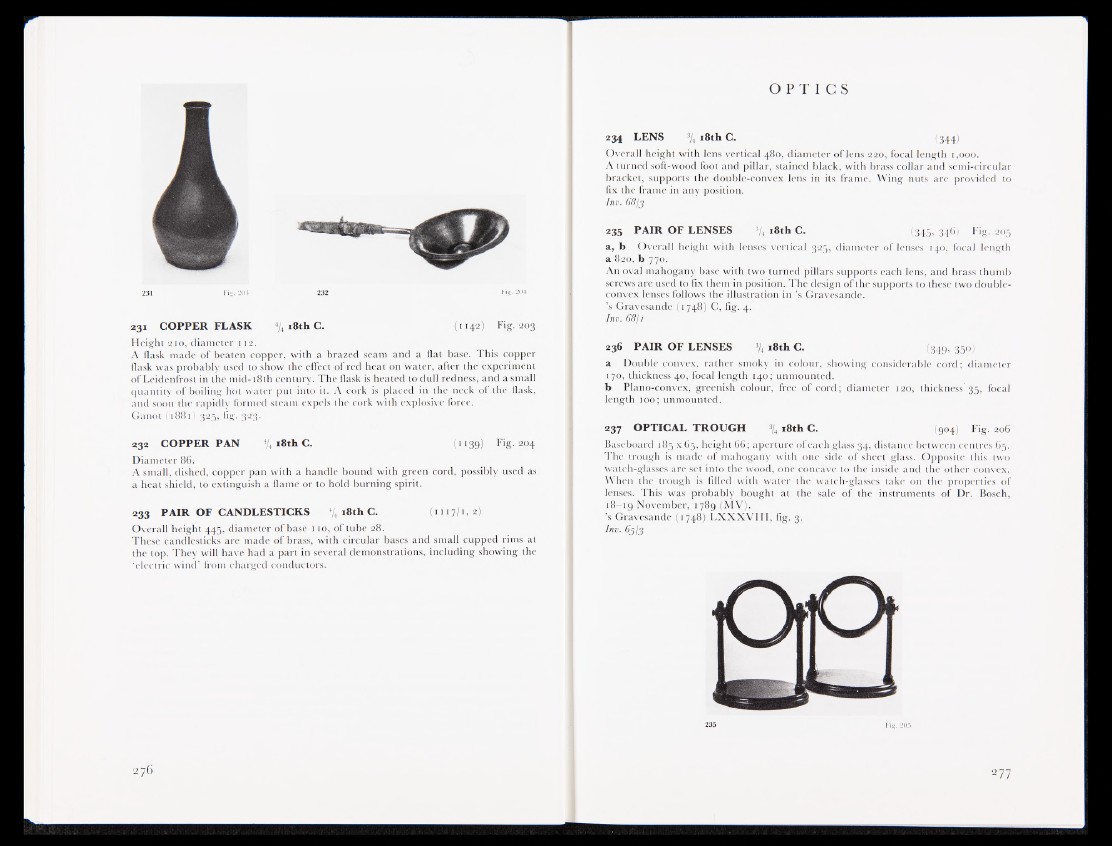
231 Fig. 2 03 232 Fig. 2®t
231 COPPER FLASK % 18th C. M i 142) Fig. 203
Height 210, diameter 112.
A flask made of beaten copper, with a brazed seam and a flat base. This copper
flask was probably used to show the effect of red heat on water, after the experiment
of Leidenfrost in the mid-i8th century. The flask is heated to dull redness, and a small
quantity of boiling hot water put into it. A cork is placed in the neck of the flask,
and soon the rapidly formed steam expels the cork with explosive force.
Ganot (1881) 325, fig. 323.
232 COPPER PAN % 18th C. ||jii39) Fig. 204
Diameter 86.
A small, dished, copper pan with a handle bound with green cord, possibly used as
a heat shield, to extinguish a flame or to hold burning spirit.
233 PAIR OF CANDLESTICKS '% 18th C. S 1 117/1 *«^;
Overall height 445, diameter of base 110, of tube 28.
These candlesticks are made of brass, with circular bases and small cupped rims at
the top. They will have had a part in several demonstrations, including showing the
‘electric wind’ from charged conductors.
O P T I C S
234 LENS % 18th C. ( 344)
Overall height with lens vertical 480, diameter of lens 220, focal length 1,000.
A turned soft-wood foot and pillar, stained black, with brass collar and semi-circular
bracket, supports the double-convex lens in its frame. Wing nuts are provided to
fix the frame in any position.
Inv. 68/3
235 PAIR OF LENSES 3/4 18th C. J345, 346) Fig. 205
a, b Overall height with lenses vertical 325, diameter of lenses 140, focal length
a 820, b 770.
An oval mahogany base with two turned pillars supports each lens, and brass thumb
screws are used to fix them in position. The design of the supports to these two double-
convex lenses follows the illustration in ’s Gravesande.
’s Gravesande (1748) C, fig. 4.
Inv. 68I1
236 PAIR OF LENSES 3/4 18th C. (349, 350)
a Double convex, rather smoky in colour, showing considerable cord; diameter
170, thickness 40, focal length 140; unmounted.
b Plano-convex, greenish colour, free of cord; diameter 120, thickness 35, focal
length 100; unmounted.
237 OPTICAL TROUGH \ l8th c . (904) Fig 2o6
Baseboard 185 x 65, height 66; aperture of each glass 34, distance between centres 65.
The trough is made of mahogany with one side of sheet glass. Opposite this two
watch-glasses are set into the wood, one concave to the inside and the other convex.
When the trough is filled with water the watch-glasses take on the properties of
lenses. This was probably bought at the sale of the instruments of Dr. Bosch,
18—19 November, 1789 (M V B B
’s Gravesande (1748) LXXXVIII, fig. 3.
Inv. 65I3